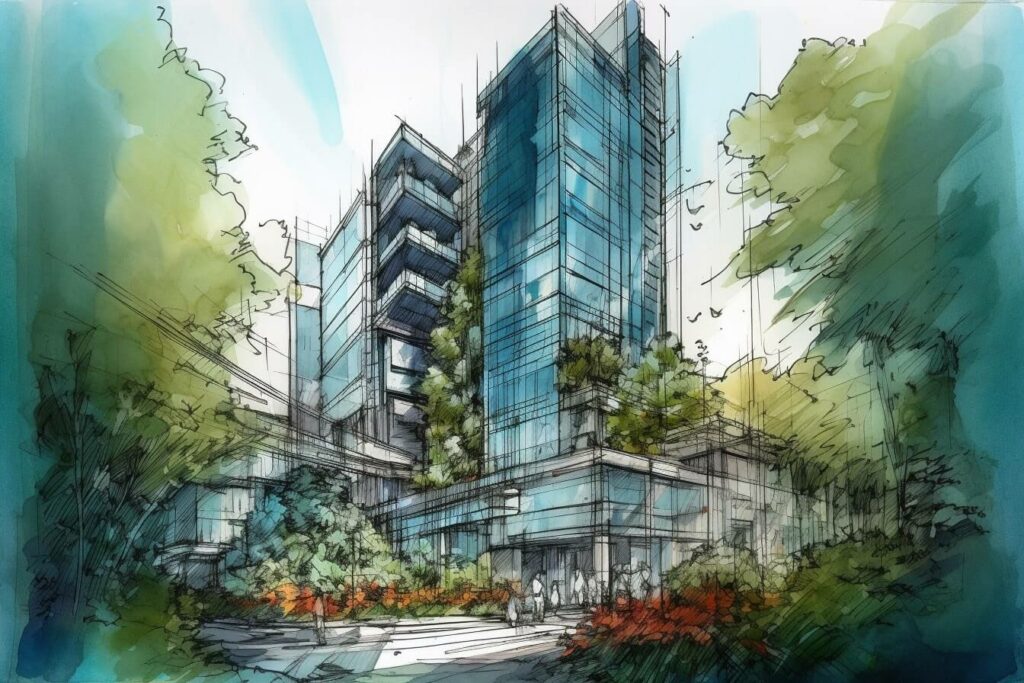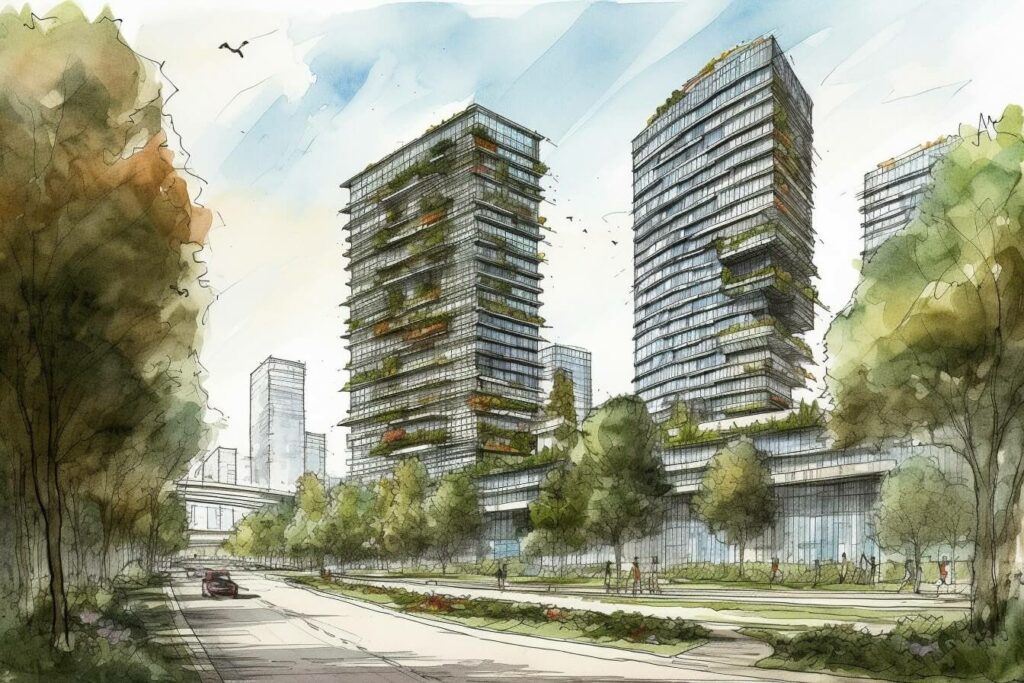Unlock Premium, Members-Only Content
Your source for the most relevant updates in sustainable construction
Sustainability has become an essential factor in the construction industry due to the impact of buildings on the environment. Buildings are responsible for a significant portion of energy consumption and greenhouse gas emissions, making them a critical area of focus for sustainability efforts. Consequently, there is an increasing demand for environmentally friendly buildings that are energy-efficient, sustainable, and have a minimal environmental impact.
LEED certification has emerged as a popular way for buildings to demonstrate their commitment to sustainability. LEED certification is recognized globally as a certification program that independently verifies a building’s environmental performance.
The certification recognizes buildings designed and built using strategies to achieve high performance in critical human and environmental health areas, such as sustainable site development, water savings, energy efficiency, materials selection, and indoor environmental quality.
As the demand for environmentally friendly buildings continues to increase, so does the interest in LEED certification. However, many people are unsure about the costs of obtaining LEED certification and how to keep those costs down. In this article, we will break down the costs associated with LEED certification and provide tips to help you keep those costs under control.
What is LEED Certification?
LEED certification is a rating system developed by the United States Green Building Council (USGBC) to encourage sustainable design and building practices. LEED stands for Leadership in Energy and Environmental Design. It is a globally recognized certification program that provides independent verification that a building was designed and built using strategies to achieve high performance in critical human and environmental health areas.
The LEED certification process is based on a point system that evaluates a building’s sustainability across several categories, including sustainable site development, water efficiency, energy and atmosphere, materials and resources, indoor environmental quality, innovation, and regional priority. Each category is assigned a certain number of points, and a building must earn a minimum number of points to achieve certification. The levels of certification are Certified, Silver, Gold, and Platinum, with Platinum being the highest level of certification.
LEED certification is a voluntary program, and buildings can pursue certification for new construction, existing buildings, commercial interiors, and homes. The certification process involves documentation and verification by a third-party organization, which ensures that the building meets the rigorous sustainability standards set by the USGBC.
In addition to demonstrating a building’s commitment to sustainability, LEED certification offers several benefits, including improved energy efficiency, reduced environmental impact, improved indoor air quality, and increased property value. It also helps building owners and operators save money on operating costs, as sustainable buildings are generally more energy-efficient and have lower maintenance costs over time.
Overall, LEED certification is an essential tool for promoting sustainable building practices and reducing the environmental impact of buildings. By providing independent verification of a building’s sustainability, LEED certification helps to building owners and operators demonstrate their commitment to sustainability while reaping the benefits of reduced operating costs and increased property value.

Costs Associated with LEED Certification
When pursuing LEED certification, several costs need to be taken into account. The cost of certification can vary widely depending on the building type, the project size, and the certification level you seek. Here are the different costs that you need to consider:
Cost of LEED Certification #1: Registration Fee
The registration fee is the first cost you will incur when pursuing LEED certification. This fee is based on the project size and the building type.
The fee ranges from $1,200 to $2,750 for new construction projects and from $900 to $1,750 for existing buildings. This fee is paid upfront to register your project with the USGBC and initiate the certification process.
Cost of LEED Certification #2: Certification Fee
Once you have registered your project, you must pay the certification fee. This fee is based on the size of the project and the level of certification you are seeking.
The fee ranges from $2,500 to $22,000 for new construction projects and from $1,750 to $15,000 for existing buildings. This fee is paid after your project has been reviewed and verified by the USGBC and is awarded certification.
Cost of LEED Certification #3: Consultant Fees
To achieve LEED certification, you will likely need to hire a consultant to help guide you through the process. The consultant fees can vary widely depending on the size and complexity of the project, as well as the consultant’s experience and expertise.
On average, consultant fees can range from $10,000 to $30,000. However, hiring a consultant can help you identify cost-saving opportunities and avoid costly mistakes, ultimately reducing the overall certification cost.
Cost of LEED Certification #4: Testing and Verification Fees
An independent third party must test and verify your building to achieve LEED certification. The testing and verification fees can range from $1,000 to $10,000, depending on the size and complexity of the project.
These fees cover the cost of site visits and testing to verify that your building meets the sustainability requirements for certification.
Cost of LEED Certification #5: Additional Costs
Additional costs may be associated with LEED certification, such as upgrading equipment or systems to meet LEED requirements. These costs vary widely depending on the building and the certification level you seek.
However, implementing sustainable features can result in long-term cost savings, such as reduced energy and water consumption, which can offset the initial costs of upgrading equipment or systems.
Overall, the cost of LEED certification can be significant, especially for larger and more complex projects. However, you can achieve LEED certification without breaking the bank by carefully considering the costs and keeping them down, such as hiring an experienced consultant and implementing cost-effective, sustainable features.
Unlock Premium, Members-Only Content
Your source for the most relevant updates in sustainable construction
Tips for Keeping LEED Certification Costs Down
Achieving LEED certification can be expensive, but there are several ways to keep the costs down while still achieving your sustainability goals. Here are some tips to help you keep your LEED certification costs under control:
Reducing the Cost of LEED Certification Tip #1: Start Early
Starting the planning process early and involving your team as soon as possible can help you identify cost-saving opportunities and avoid costly mistakes. The earlier you start, the more time you will have to evaluate your options and make informed decisions.
Reducing the Cost of LEED Certification Tip #2: Choose the Right Level of Certification
Each level of LEED certification comes with different costs and benefits. Consider the costs and benefits of each certification level before deciding. Choosing the right level of certification can help you balance the costs and benefits of achieving LEED certification.
Reducing the Cost of LEED Certification Tip #3: Consider the Long-Term Benefits
While achieving LEED certification can be expensive, it can save long-term costs. For example, sustainable features such as energy-efficient lighting and water-saving fixtures can reduce energy and water consumption, resulting in lower operating costs over time. Consider the long-term benefits of sustainable design when evaluating the costs of achieving LEED certification.
Reducing the Cost of LEED Certification Tip #4: Work with Experienced Professionals
Working with experienced professionals, such as architects and engineers, can help you identify cost-saving opportunities and avoid costly mistakes. Look for professionals who have experience with LEED certification and sustainable design. They can help you evaluate your options and make informed decisions that balance costs and benefits.
Reducing the Cost of LEED Certification Tip #5: Utilize Incentives and Grants
There may be incentives and grants available to help offset the cost of LEED certification. Check with your local and state governments and utility companies to see what incentives and grants are available in your area. Utilizing these incentives and grants can significantly reduce the costs of achieving LEED certification.
Reducing the Cost of LEED Certification Tip #6: Implement Simple Strategies
You can implement simple strategies to achieve LEED certification without breaking the bank. For example, you can use low-flow faucets and toilets to reduce water consumption or install energy-efficient lighting to lower energy consumption. These strategies are often cost-effective and can help you achieve LEED certification while decreasing costs.
By following these tips, you can control your LEED certification costs while achieving your sustainability goals. Achieving LEED certification is an investment in the sustainability of your building, and it can result in long-term cost savings. By understanding the costs and taking steps to keep them down, you can achieve LEED certification without breaking the bank.

Cost of LEED Certification: Conclusion
Sustainable building practices have become increasingly important in the construction industry, and LEED certification is a popular way for buildings to demonstrate their commitment to sustainability. While achieving LEED certification can be expensive, it is an investment in the sustainability of your building and can result in long-term cost savings.
In this article, we have broken down the costs associated with LEED certification and provided tips to help you keep those costs under control. By starting early, choosing the right level of certification, considering the long-term benefits, working with experienced professionals, utilizing incentives and grants, and implementing simple strategies, you can achieve LEED certification without breaking the bank.
As architects, interior designers, and construction companies, knowing the costs and benefits of LEED certification and helping clients make informed decisions about sustainable building practices is essential. By understanding the costs and benefits of LEED certification, you can help your clients achieve their sustainability goals while controlling costs.
In conclusion, LEED certification is an essential tool for promoting sustainable building practices and reducing the environmental impact of buildings. Taking steps to control certification costs can make sustainable building practices accessible to more people and help create a more sustainable future for all.
Cost of LEED Certification: FAQs
What is the process for obtaining LEED certification?
The process for obtaining LEED certification involves several steps, including registering your project with the USGBC, selecting a level of certification, submitting documentation to demonstrate compliance with LEED requirements, and undergoing third-party verification. The process can be complex, and working with an experienced consultant who can guide you is often helpful.
How long does it take to obtain LEED certification?
The time it takes to obtain LEED certification varies depending on several factors, including the size and complexity of the project, the certification level you seek, and the documentation availability. The process can take several months to a year or more, so it is important to start early and allow enough time for the certification process.
Can existing buildings obtain LEED certification?
Existing buildings can obtain LEED certification through the LEED for Existing Buildings: Operations and Maintenance (LEED EBOM) rating system. This rating system is designed to help building owners and operators improve the sustainability of their existing buildings through sustainable operations and maintenance practices.
Is LEED certification mandatory for new construction projects?
No, LEED certification is not mandatory for new construction projects. It is a voluntary program that building owners and operators can pursue to demonstrate their commitment to sustainability and reap the benefits of sustainable design and building practices.
Does LEED certification apply to residential buildings?
Yes, LEED certification applies to single- and multi-family residential buildings. The LEED for Homes rating system is designed specifically for residential buildings and evaluates sustainability across several categories, including energy efficiency, indoor air quality, and water conservation.
What are some cost-saving strategies for achieving LEED certification in construction projects?
Some cost-saving strategies for achieving LEED certification in construction projects include starting early, choosing the right level of certification, considering the long-term benefits, working with experienced professionals, utilizing incentives and grants, and implementing simple strategies such as using energy-efficient lighting and water-saving fixtures. This can mitigate the cost of LEED Certification.
Unlock Premium, Members-Only Content
Your source for the most relevant updates in sustainable construction
If you need our services in the Portuguese language, click here.